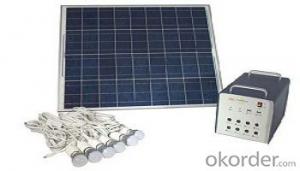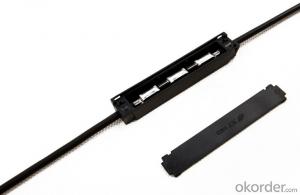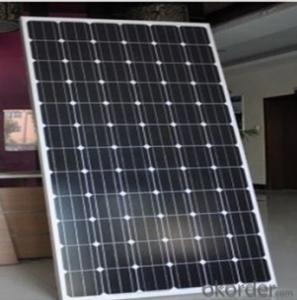Solar System 10KW
- Loading Port:
- China Main Port
- Payment Terms:
- TT or LC
- Min Order Qty:
- -
- Supply Capability:
- -
OKorder Service Pledge
Quality Product, Order Online Tracking, Timely Delivery
OKorder Financial Service
Credit Rating, Credit Services, Credit Purchasing
You Might Also Like

- Q:Can solar energy systems be used in powering traffic signals?
- Yes, solar energy systems can indeed be used to power traffic signals. Solar panels, also known as photovoltaic (PV) modules, can convert sunlight into electricity, which can then be used to power various devices, including traffic signals. This has several advantages over traditional grid-powered traffic signals. Firstly, solar-powered traffic signals are more environmentally friendly as they do not rely on fossil fuels or emit greenhouse gases during operation. This helps in reducing carbon footprint and combating climate change. Secondly, solar-powered traffic signals are independent of the electrical grid, making them more reliable during power outages or grid failures. They can continue to function even when there is a disruption in the main power supply, ensuring the smooth flow of traffic and maintaining safety on the roads. Furthermore, solar-powered traffic signals require minimal maintenance compared to their grid-powered counterparts. Once installed, solar panels have a long lifespan and only require occasional cleaning to ensure optimal performance. This reduces the need for frequent repairs and upkeep, resulting in cost savings for the traffic management authorities. Lastly, solar-powered traffic signals can be installed in remote or off-grid locations where it would be challenging or costly to extend the electrical grid. This makes them a viable solution for rural areas or areas with limited infrastructure. In conclusion, solar energy systems are an effective and sustainable solution for powering traffic signals. They offer numerous benefits such as environmental friendliness, reliability, low maintenance, and suitability for remote locations. With the advancement of solar technology, the use of solar-powered traffic signals is expected to increase, contributing to a greener and more efficient transportation system.
- Q:Do solar energy systems require specialized insurance?
- Specialized insurance is typically required for solar energy systems due to their nature as a significant investment and their susceptibility to various risks, including damage from natural disasters, theft, or system malfunctions. Standard homeowner's insurance policies may not offer sufficient coverage for these risks, making it prudent to obtain specialized insurance for solar energy systems. This insurance can cover expenses for repairs or replacements in case of damage or loss and also provide liability coverage for accidents or injuries related to the system. It is crucial to seek advice from insurance providers specializing in renewable energy systems to ensure that the unique requirements and risks associated with solar energy systems are adequately addressed.
- Q:How do solar energy systems impact energy resilience during natural disasters?
- Solar energy systems can greatly enhance energy resilience during natural disasters. Unlike traditional power grids that rely on fossil fuels, solar energy systems generate electricity from sunlight, making them more reliable and less vulnerable to disruptions caused by extreme weather events. During power outages, solar panels can continue to produce electricity, providing a reliable source of energy for critical infrastructure, emergency services, and households. Additionally, solar energy systems can be combined with energy storage solutions such as batteries, allowing excess energy to be stored and used when the sun is not shining, further increasing energy resilience. Overall, solar energy systems play a crucial role in ensuring a more resilient and sustainable energy infrastructure during natural disasters.
- Q:Can solar energy systems be used in powering construction sites or temporary structures?
- Yes, solar energy systems can definitely be used to power construction sites or temporary structures. In fact, solar power is increasingly being utilized in these scenarios due to its numerous advantages. Firstly, construction sites often lack access to traditional power sources, which makes solar energy a practical solution. Solar panels can be easily installed on rooftops, scaffolding, or even on the ground, providing a reliable source of electricity throughout the construction process. Secondly, solar energy systems offer flexibility in terms of power generation. They can be customized to meet specific energy demands of construction sites, whether it is for running power tools, lighting, or charging equipment. This adaptability ensures that construction activities can proceed smoothly without interruptions. Additionally, solar energy systems are environmentally friendly. By harnessing energy from the sun, construction sites can significantly reduce their carbon footprint and contribute to sustainable practices. Solar power does not produce harmful emissions or noise pollution, which is particularly beneficial in urban areas or sensitive environments. Furthermore, solar energy systems offer cost savings in the long run. While the initial investment for installing solar panels might be higher compared to traditional generators, the ongoing operational costs are significantly lower. Construction sites can benefit from reduced fuel expenses, maintenance costs, and reliance on fossil fuels. It is worth mentioning that solar energy systems can also be used for temporary structures such as mobile offices, portable restrooms, or event venues. These structures can be easily powered using solar panels, eliminating the need for generators or grid connections. In conclusion, solar energy systems are a viable and sustainable option for powering construction sites and temporary structures. They provide reliable, customizable, and cost-effective power solutions while minimizing environmental impact. As the global shift towards renewable energy continues, solar power will likely become even more prevalent in construction industry practices.
- Q:Can solar energy systems be used in areas with limited access to information technology?
- Yes, solar energy systems can be used in areas with limited access to information technology. Solar energy systems primarily function using photovoltaic cells that convert sunlight into electricity, which does not require frequent monitoring or maintenance. These systems can be installed and operated without the need for complex information technology infrastructure. Therefore, even in remote or underdeveloped areas with limited access to information technology, solar energy systems can still be effectively utilized to provide sustainable and reliable power.
- Q:What is net metering and how does it work with solar energy systems?
- Net metering is a billing arrangement that allows solar energy system owners to receive credit for the excess electricity they generate and feed back into the grid. With net metering, when a solar energy system produces more electricity than is being consumed, the excess energy is sent back to the power grid, and the homeowner or business owner receives a credit on their utility bill. This credit can then be used to offset the cost of electricity when the solar system is not generating enough power, such as during nighttime or cloudy days. Essentially, net metering ensures a fair and efficient exchange of electricity between the solar system owner and the utility company, making solar energy systems more economically viable and accessible.
- Q:How do solar energy systems impact the demand for traditional energy sources?
- Solar energy systems reduce the demand for traditional energy sources by providing a clean and renewable alternative. As more solar energy is generated and integrated into the grid, the need for fossil fuels and other non-renewable sources decreases, leading to a decrease in overall demand for traditional energy sources.
- Q:How do solar energy systems impact the stability of the electrical grid?
- The stability of the electrical grid can be influenced in both positive and negative ways by solar energy systems. On the one hand, these systems aid in diversifying the energy mix by providing an environmentally friendly and renewable source of electricity. This reduces reliance on fossil fuels and lessens greenhouse gas emissions, thereby promoting a more sustainable grid. Furthermore, solar energy systems can enhance grid stability by decreasing the demand for electricity during daylight hours. When the sun is shining, solar panels generate electricity at their maximum capacity, which can offset the need for fossil fuel power plants to operate at peak levels. This helps alleviate strain on the grid during periods of high demand, ultimately preventing potential power outages or blackouts. Nonetheless, solar energy systems also present challenges to the stability of the electrical grid. The intermittency of solar power generation, for instance, poses a significant obstacle. Since solar power relies on weather conditions, it fluctuates throughout the day. This fluctuation can create imbalances between electricity supply and demand, potentially destabilizing the grid. To address this issue, grid operators must effectively manage the integration of solar energy systems into the grid by implementing advanced forecasting and grid management technologies. Moreover, in certain regions with a high penetration of solar energy systems, there can be an excess of electricity during peak solar production hours. This surplus energy may not be efficiently utilized or stored, leading to voltage fluctuations and grid instability. Grid operators must invest in energy storage technologies, such as batteries, to store excess solar power and release it when needed, ensuring grid stability. In conclusion, solar energy systems exert a significant influence on the stability of the electrical grid. While they contribute to a cleaner and more sustainable energy mix, their intermittent nature and potential for over-generation necessitate careful grid management and the integration of energy storage technologies. With proper planning and investment, solar energy systems can play a vital role in achieving a stable and resilient electrical grid.
- Q:Can a solar energy system be installed in an area with heavy snowfall?
- Indeed, it is possible to install a solar energy system in an area that experiences heavy snowfall. Although the efficiency of the system may be affected by the snow, it is not completely rendered ineffective. There are various considerations and adjustments that can be made to ensure the system remains operational even in snowy conditions. To begin with, the angle and orientation of the solar panels can be modified to optimize sunlight absorption and minimize snow accumulation. By installing the panels at a steeper angle or utilizing tracking systems, snow can be more easily shed. Furthermore, aligning the panels towards the south can assist in snow removal by allowing for better exposure to sunlight. Moreover, it is essential to perform regular maintenance and clean the panels during periods of heavy snowfall. Manual removal of snow from the panels or the use of specialized snow rakes can restore their efficiency. Some solar energy systems are equipped with self-cleaning mechanisms or heating elements that can melt snow and ice. Lastly, it is important to consider the capacity and storage options of the solar energy system. In areas with heavy snowfall, there may be occasions when the panels remain covered with snow for extended periods. In such scenarios, having an adequate battery storage system or a backup power source can ensure a continuous energy supply during snowstorms. To conclude, while heavy snowfall may present challenges to a solar energy system, it is still viable to install one in such locations. With proper design, maintenance, and storage choices, solar energy systems can continue to harness the power of the sun even in snowy conditions.
- Q:Can solar energy systems be used for powering security cameras?
- Certainly, security cameras can indeed be powered by solar energy systems. The conversion of sunlight into electricity by solar panels enables the storage of energy in batteries or direct powering of different devices, such as security cameras. Consequently, solar energy emerges as an excellent and sustainable option for remote or off-grid areas where the installation of electrical cables might pose challenges or incur high expenses. Moreover, solar-powered security cameras possess the advantageous ability to function without interruption, provided there is an ample supply of sunlight to generate electricity. Consequently, they prove to be a dependable and environmentally friendly alternative for surveillance systems.
1. Manufacturer Overview |
|
|---|---|
| Location | |
| Year Established | |
| Annual Output Value | |
| Main Markets | |
| Company Certifications | |
2. Manufacturer Certificates |
|
|---|---|
| a) Certification Name | |
| Range | |
| Reference | |
| Validity Period | |
3. Manufacturer Capability |
|
|---|---|
| a)Trade Capacity | |
| Nearest Port | |
| Export Percentage | |
| No.of Employees in Trade Department | |
| Language Spoken: | |
| b)Factory Information | |
| Factory Size: | |
| No. of Production Lines | |
| Contract Manufacturing | |
| Product Price Range | |
Send your message to us
Solar System 10KW
- Loading Port:
- China Main Port
- Payment Terms:
- TT or LC
- Min Order Qty:
- -
- Supply Capability:
- -
OKorder Service Pledge
Quality Product, Order Online Tracking, Timely Delivery
OKorder Financial Service
Credit Rating, Credit Services, Credit Purchasing
Similar products
New products
Hot products
Hot Searches
Related keywords


























